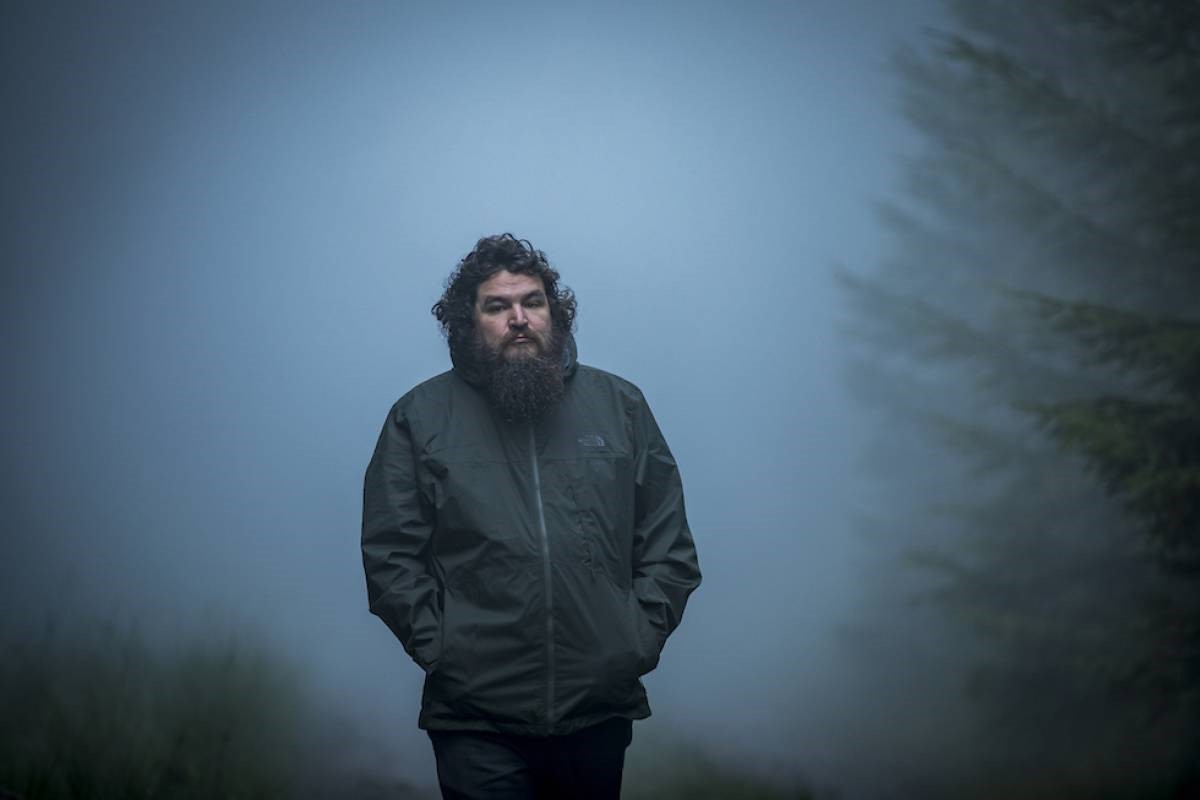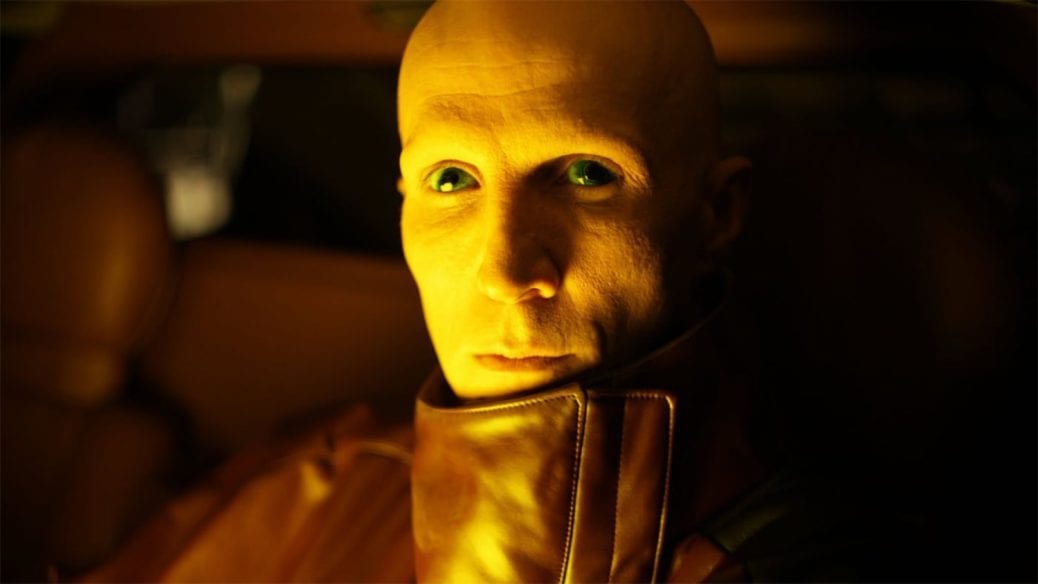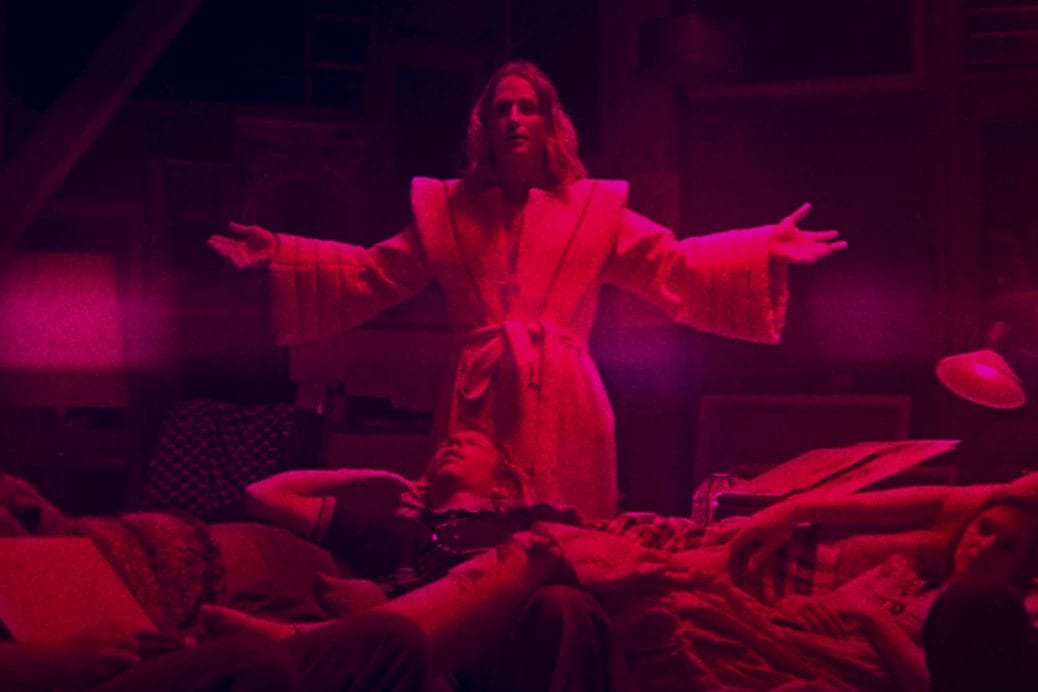
Exclusive interview with the critically acclaimed director Panos Cosmatos
Panos Cosmatos on Mandy, utilizing Nicolas Cage and the abstract dreamscape of imaginary films.
He came out of nowhere and now he’s on every film critic’s lips. Panos Cosmatos is the director behind the critically acclaimed horror movie “Mandy”, starring Nicolas Cage and Andrea Riseborough. We had a chat with him on everything from the similarities between Mandy’s hippie cult leader villain and president Donald Trump, to following his father (the Hollywood director George P. Cosmatos) to different movie sets.
Director Panos Cosmatos’ second movie Mandy is nothing like the commercial teen slashers you’re used to. It’s art-house gone gore. In the leading role, we see Nicolas Cage as Red, a lumberjack who goes rogue on the hippie cult that murdered his wife Mandy (Andrea Riseborough). He fights them with anything he gets his hands on: an axe, a baseball bat, a chainsaw, everything mixed with beautiful slow-motion shots and dreamlike neon-toned color filters. Nobody could foresee that Mandy would be a critical smash-hit. We met Panos for an exclusive interview and had a great talk on his love of cinema, taking the chance to utilize a proper "Cage-rage", the roots of Jeremiah (the hippie cult leader Nic is chasing after), and a lot more.
– Did you know that I am half Swedish? asks Panos Cosmatos as I enter the room in the HKX building in London. I meet his smile and ask him if he knows any words, and with a thick American accent, he replies “Tack så mycket, jag mår bra. Jag älskar dig”. Which means “Thanks a lot, I’m fine. I love you". We sit down at the big table in the center of the room.
While Cosmatos first movie “Beyond the Black Rainbow” flew below most radars, "Mandy" is one of the very few genre films that has received wide universal acclaim. At the festival in Cannes, the response was incredible – a five-minute-long standing ovation. Nothing Panos was prepared for.
– I really put a lot of myself emotionally into the movie. I figured the reactions would maybe be slightly more positive than my first film, since Mandy, by the nature of the topic and the setting, is more of a crowd pleaser. Black Rainbow was a very difficult film by design. A very contained film about suppressing emotions, while Mandy is about releasing them. It’s a lot more of my heart, and the things that I love in it. I think people respond to that. There’s a lot of love in Mandy.
The connection between “Black Rainbow” and “Mandy” seems strong and personal for Panos. Like they are two sides of an internal battle.
– I started writing it at the same time as Black Rainbow. In retrospect, I think Mandy was an antidote to that grueling and emotional experience, that I unconsciously needed a release from it.
Since then, how much have you changed in the script?
– The way I've put these two movies together has been a very editorial process. I used to work with making collages and photographies, and I approach my movies in a similar way. I think of them, not as much as stories, but almost as conceptual art pieces. Like pop art. So, it’s a very weird editorial and sculptural process, building them and making them feel right.
“I have a strange childhood memory, picking up the blank shells from the machine gun bullets”

Panos Cosmatos was born into the cultural world. His mother Birgitta Ljungberg-Cosmatos was a Swedish sculptor and his father George P. Cosmatos was the Hollywood director behind movies such as “Escape to Athena” – starring screen legend David Niven, Roger Moore, and Elliott Gould –, the Sylvester Stallone movie “Cobra” and star-packed western “Tombstone”. Panos is fast on acknowledging his parents' influence.
– These movies wouldn’t be the same without them. My mother was very nurturing of my creativity, and my father had a more pragmatic approach, but at the same time, he deeply loved movies. He had a giant collection of Betamax tapes he made of C-channel, Showtime, HBO and stuff throughout the 80’s. He was not likely to organize them, and there were like two movies per tape, none of them in alphabetical order. I just picked stuff at random based on the logo he cut and pasted out of cable guide. There was stuff from every area and genre. At a very young age, I ended up seeing a huge cross-section of film from all over the world. All my favorite discussions I remember having with him were always about movies.
As a kid, did you ever follow him to set?
– We would go and visit him if I weren’t in school. Some of my earliest memories, I think, are being at the set of Escape of Athena. I have a strange childhood memory, picking up the blank shells from the machine gun bullets.
Later on, Panos Cosmatos worked with his father on the set of “Tombstone”.
– I was video assistant on the second unit. A separate crew that was filming people on horses, close-ups on gun barrels and stuff like that.
“I still try to think of it like making Super 8 art films”

Did you already back then want to make movies?
– I've always been obsessed with certain films. They are a huge part of my life. But I wasn’t sure that I wanted to make them until the late 80’s when I back-to-back saw Scorsese’s After Hours and Evil Dead II. There was something about the humor and the way the camera movements were so… mechanical and drew attention to themselves, that just made it click in my mind. I realized that the director could use the camera as a brush, or a tool, to tell their stories and express themselves.
Were there any specific scenes that made you realize this? Like the opening shot of Evil Dead II?
– Yeah, that one, and also in After Hours there was these very beautiful, very mechanically feeling tracking shots that really drew attention to themselves as a film technique. I felt that there was something amazing about that. This idea of drawing attention to the mechanics behind it.
In Mandy, you’ve got these really strong color filters and slow-motion shots blended in a quite unique visual style. Was the final result like you imagined it to be?
– Yeah, I still try to think of it like making Super 8 art films. Even if the resources behind me are so much larger than making a Super 8 short film at home, I still think of it in the same way. I’m just trying to express myself in an odd personal way through these strange stories.
But was it tricky to get the feeling that you wanted?
– I don’t know. It didn’t feel tricky. You work hard throughout the pre-production process to make sure that you have everything you need to create these images that you want. The only difficult part is if you don’t have enough time. Then it can become very stressful to try to get all the footage you need.
“I basically had tried to obliterate my consciousness for the past ten years”
From Tombstone to Black Rainbow there’s a gap of seventeen years. How come, what happened in-between?
– Well, in 1997 my mother passed away and I kind of spiraled into a state of self-destruction. I didn’t even realize it was happening until my father died. Then I understood that I basically had tried to obliterate my consciousness for the past ten years. That I had totally subsumed the grief of my mother, and that my father's death would compound on top of it. I had to do something about it.
And that something was Black Rainbow?
– Yeah, I went to therapy and finally started to cope with the grief. You know, feel it instead of pushing it away out of fear. As a result, I had a moment of clarity. I was in my home at the time and I imagined myself in that same room, ten years later, still not having made a film, or even tried to make a one… and I thought, what an incredibly dishonorable way to die [bursts out laughing].
So all these years, you had it in the back of your mind that you wanted to make a film?
– Yeah… and that moment of clarity was like a fire being lit beneath me. It basically propelled me forward through my fear and through my anxiety to make Black Rainbow.
Are you feeling all right now?
– Yeah, I am all right. I’m very happy that people are responding to Mandy.
“I mean what is that? What is an imaginary film?”
The story of “Mandy” is set in the year 1983. The reason for this is not the fashionable Hollywood-turns-a-buck-on-nostalgia-trip we've seen since “Stranger Things” exploded in every home. For Panos, it's way more personal.
– The original concept that spun both of these movies out, was this memory of being in a video store as a kid and looking at the horror films I weren’t allowed to watch. Reading the description and imagining what the film would be like. I remember that and the idea of an imaginary film fascinates me. I mean what is that? What is an imaginary film?
So in an alternative version of 1983, you would be looking at the covers of Black Rainbow and Mandy?
– Yeah, 1983 for me is a signifier for this sort of imaginary world where these films exist. Movies that only exists in one’s imagination.
Nicolas Cage is really great in Mandy, I haven’t seen him this on spot in years. Was the role written for him?
– Once he finally agreed to play Red, I rewrote a bunch of it with him in mind. I didn’t want to squander the opportunity of being able to utilize Nicolas Cage [laughs hard]. I’m really proud of his performance. I think it’s one of the more interesting parts he's played.
“I almost started to see Jeremiah as a weird hybrid of Mike Pence and Trump”

Another great part is Linus Roache as the cult leader Jeremiah. There are some similarities between Jeremiah and Charles Manson. He refers to his victims as pigs and is a musician leading a hippie cult. Coincidentally or not?
– I feel like a lot of cult leaders have similarities between them, but yeah, there's definitely some Manson in there. With Jeremiah, I was drawing from a lot of different sources, read a lot about cults and stuff. As we got closer to film production, it happened to coincide with Donald Trump getting voted into office… and I almost started to see Jeremiah as a weird hybrid of Mike Pence and Trump. Like they merged into one person of religious fanaticism and delusional egomania.
Mandy’s hypnotic synth and guitar-driven soundtrack is made by the late Icelandic composer Jóhann Jóhannsson. A worthy final note from one of the most interesting composers of modern times. In one scene, the character Mandy is reading a book called “Seeker of the Serpents Eye” and the score in that scene has the same title. I was curious about how Panos worked with Jóhansson during the filmmaking.
– Jóhann made sketches early on from a playlist I gave him. But he didn’t jump into the deep end of heavy lifting until we were in the second phase of editing and provided him a rough cut. He went away and started generating tracks. And when we went through our final edit he refined them and refined them.
“Maybe I’ll make a movie where Elijah Wood plays every character”
“The Lord of the Rings” star Elijah Wood has had a really fascinating career since the closure of the trilogy. Instead of making new grand-scale blockbusters, he's focusing on small indie films, mainly horrors. One of these is “Mandy”, which he is co-producing.
– I wanted to make sure that whomever I worked with on my next film, would nurture and protect it. I had heard so many horror stories from directors being bent over the barrel for ridiculous reasons. I was very cautious about whom to engage with. Elijah saw Black Rainbow in L.A., came to me and said that he wanted to work together. He’s just a real fan of horror films and genre films in general. All the producers of Mandy are so genuine. And they were true to their word. They protected the film for all those years. I would love to work with them again
Maybe Elijah Wood wili star in the next one?
– Maybe I’ll make a movie where Elijah Wood plays every character [bursts out laughing].
With that, we thank Panos Cosmatos for the talk. Of course, we hope that it won't be another eight years until his next film, and that Panos uses his idea of having Elijah Wood to play every character. If you haven't seen Mandy yet, do it. You're in for a treat.